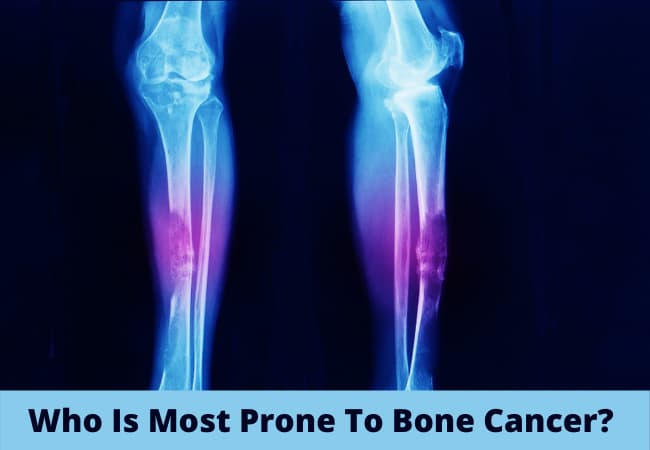

Bone cancer can start in any bone in your body. However, it most commonly affects the long bones in the arms and legs or the pelvis. Bone cancer is very rare, making up less than 1 per cent of all the cancers. In actual fact, noncancerous bone tumors are much more common compared to the cancerous ones.
Some types of bone cancer usually occur in kids, while others affect adults. Bone cancer is classified according to the cells where the cancer has developed . This can be :
Osteosarcoma. Osteosarcoma is known to be the most common form of bone cancer. In such tumor, cancerous cells produce bone. This type of bone cancer occurs most frequently in young adults and children, in the bones of the arm or leg.
Chondrosarcoma. Chondrosarcoma is known to be the second most common form of bone cancer where cancerous cells produce cartilage. Generally, chondrosarcoma occurs in the arms, legs or pelvis, in middle-aged and older adults.
Ewing sarcoma. Ewing sarcoma tumours most commonly occurs in the arms, legs, or pelvis of children and young adults.
Cancer that has spread from other parts of the body to the bones is called Secondary Bone Cancer or metastatic cancer. Cancer can spread to the bones from the breast, prostate, or lungs
There are many symptoms of bone cancer; some of the most prevalent bone cancer symptoms are:
The process of determining the extent of spread of cancer is known as staging. The severity of bone cancer depends upon its stage. Bone cancers are categorized into 4 stages – stage 1, stage 2, stage 3, and stage 4. Stage 1 indicates that cancer has not spread , while during stage 4, the cancer cells are known to have spread to distant organs in the body . Hence, the higher the stage, the higher are the complications related to cancer.
The stages of bone cancer are usually determined by the following parameters:
Although there are no specific causes of bone cancer, doctors have found certain factors associated with the risk of acquiring it. Some of the reasons why bone cancer symptoms occur are:
Although most bone cancers do not appear to be hereditary, some might be caused due to defects in certain genes. Those with a mutation in the RB1 gene, which usually causes retinoblastoma, have shown an increased risk of developing bone cancer.
This condition is characterized by the presence of multiple bumps in the bones. These bumps are made of cartilage and may deform the bone. Patients with this condition have an increased risk of primary bone cancer. Pain and swelling is a common bone cancer symptom in this case.
Patients with tuberous sclerosis syndrome are also at risk of bone cancer.
This is a precancerous condition that usually occurs mostly in people older than 50 years. This disease causes the formation of abnormal bone tissue resulting in thick, heavy, and brittle bones. 1% of the people with this condition develop bone cancer symptoms.
Exposure to radiation during radiotherapy for cancer may increase the risk for bone cancer in the future .
When to See a Doctor?
In case of the occurrence of any bone cancer symptoms, get an appointment with a doctor. If the doctor is suspicious about the possibility of bone cancer, they may refer you to an Oncologist. Meanwhile, here are a few things that are important to keep a note of:
Call 1860-500-1066 to book an appointment
The doctor would suggest a few tests and scans like X-rays, CT scans, MRI scans, bone scans, and Biopsy.
Various treatment options for bone cancer are:
It is the primary treatment for most types of bone cancer. The main goal is to remove the cancer affected part entirely.
It is usually administered after surgery to remove any residual cancerous cells.
Ewing sarcoma and osteosarcoma are often treated by administering chemotherapy
This includes the administration of specialised medicines that target the cancer cells , for diseases like chordomas and other bone cancers, where chemo has not been beneficial.
After surgery, fitting for a prosthetic limb, rehabilitation, and/or physical therapy might be important to help you regain as much of your mobility and independence as possible. Recovery from bone cancer usually depends on the severity and type of cancer. Almost 75% of patients who have recovered live at least 5 years post-diagnosis.
Coping and support
Diagnosis of cancer, once bone cancer symptoms occur, can be physically and mentally exhausting. The fear and stigma related to cancer are well-founded. There are a few ways to cope with the physical and mental stress.
Extensive reading on cancer or asking the doctor about treatment options is a way to become more confident. As a person gains knowledge on this subject, the fear and uncertainties slowly melt away.
Engaging with close family members and friends can be of support in difficult times.
Conversing with cancer survivors can help develop a positive outlook. It also provides the correct and necessary information required to stay informed.
Conclusion
Bone cancer, if detected within the early stages, is curable. Continuous research is being conducted to find its cure, and new treatment procedures are being introduced . It is possible to lead a normal life after treatment.
Frequently Asked Questions (FAQs)
There are no dietary restrictions as such, but a balanced diet is vital for speedy recovery.
It is not clear which practices lower the chances of bone cancer progressing or coming back. Adopting a healthy lifestyle, a balanced diet, and regular exercise have positive effects on overall health.
Call 1860-500-1066 to book an appointment
Our dedicated team of experienced Oncologists verify the clinical content and provide medical review regularly to ensure that you receive is accurate, evidence-based and trustworthy cancer related information
